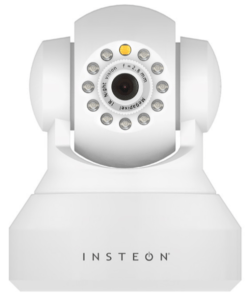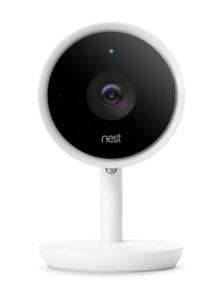Webcam Security
 Webcam Security: a reader asks…
Webcam Security: a reader asks…
I am looking at adding a wireless webcam or two to help monitor my home when I’m away. I’m worried about security, but also about the security of the webcams I get. I hear they’re not very secure. Do you have any recommendations? I’ve been looking at the Insteon cameras (and their other home automation gear).
Unfortunately, most webcams (also called IP Cameras) on the market come from China, and are horribly insecure. In order to make a webcam that works independently from your computer (as opposed to a webcam attached or built-into your computer), they must include processing power to operate as a webserver, which means being able to generate and send data out to the internet with nothing more than a WiFi or wired connection to your home router.
You’ll find tons of these IP cameras online and in computer and office supply stores under a bunch of different names. Their cost is reasonably low, and they are usually pretty easy to setup. But, they often lack even decent security. Their processors can be easily taken over by hackers. This includes webcams, IP cameras, even NannyCams. Insteon cameras from smarthome.com are no better than any of these others.
Other more premium camera lines include the Dropcam and the Nest Cam (now both part of the same company, owned by Alphabet who also owns Google). Also the Netgear Arlo line, cameras from Belkin and even Amazon has gotten into the market. There are even doorbell cameras (new ones being released all the time). Unfortunately, most of these cameras sacrifice security for usability. The only wireless security camera I’ve found that has decent (in my opinion) security is the Nest Cam IQ series, and they are significantly more expensive than your average wireless camera (costing $250 and up each).
 No internet-connected camera is going to be 100% safe, but the Nest Cam has one nice thing going for it. Whereas most IP cameras have a general-purpose hardware webserver built-in, Nest uses a proprietary system so that the camera can only communicate with either the Nest app on your smartphone or the Nest website – it cannot host its own website and can’t be accessed from an IP address. This makes is significantly harder to hack into than most of the competition. For the do-it-yourselfer, I think the Nest Cam IQ is probably the best bet. But, read on…
No internet-connected camera is going to be 100% safe, but the Nest Cam has one nice thing going for it. Whereas most IP cameras have a general-purpose hardware webserver built-in, Nest uses a proprietary system so that the camera can only communicate with either the Nest app on your smartphone or the Nest website – it cannot host its own website and can’t be accessed from an IP address. This makes is significantly harder to hack into than most of the competition. For the do-it-yourselfer, I think the Nest Cam IQ is probably the best bet. But, read on…
Some of the cameras run on battery power, but that can be a problem as you have to keep replacing the batteries (or charging the rechargeable kind). And all of these types of cameras use the WiFi radio bands (2.4ghz and 5.0ghz) to send their video out, so a burglar can use simple jamming equipment to stop the video transmission. And all the non-battery-powered cameras need to have a wire to provide electricity. That wire can be cut by a burglar, if the camera is mounted within their reach. And finally, there are plenty of cheap devices a burglar can get that could jam the WiFi radio spectrum to prevent all these cameras from sending their video out. All this to say that the glut of wireless security cameras on the market for do-it-yourselfers is a compromise between ease of installation and security.
 A good security camera system would be a professionally-installed, wired system of cameras that are hung just under the roof-line with wires run inside the attic to route both power and video signal. That generally includes a recorder device somewhere in your home so you can scroll back in time to look at past incidents that may have happened on your property. The recorder device may or may not be connected to the internet, to allow you to look at security camera footage from your smartphone or a computer. The real benefit of such a system is that it would be hard for a burglar to bypass the security camera footage. Even if they cut the power to your home, their approach would be recorded on camera and you would either be warned, or be able to go back and identify the burglar. Systems like this can cost over $1,500 just for the hardware, and as much or more for the professional installation. Not a trivial undertaking.
A good security camera system would be a professionally-installed, wired system of cameras that are hung just under the roof-line with wires run inside the attic to route both power and video signal. That generally includes a recorder device somewhere in your home so you can scroll back in time to look at past incidents that may have happened on your property. The recorder device may or may not be connected to the internet, to allow you to look at security camera footage from your smartphone or a computer. The real benefit of such a system is that it would be hard for a burglar to bypass the security camera footage. Even if they cut the power to your home, their approach would be recorded on camera and you would either be warned, or be able to go back and identify the burglar. Systems like this can cost over $1,500 just for the hardware, and as much or more for the professional installation. Not a trivial undertaking.
Setting up a good security video solution for your home takes some thought and planning, so take the time to think about your situation and look at the available products. The webcam market is changing rapidly, so do your research before you start spending money. And give serious consideration to having a professionally-installed system, even though the cost to do that will likely be a lot more than just putting a Nest cam in your window.
This website runs on a patronage model. If you find my answers of value, please consider supporting me by sending any dollar amount via:
or by mailing a check/cash to PosiTek.net LLC 1934 Old Gallows Road, Suite 350, Tysons Corner VA 22182. I am not a non-profit, but your support helps me to continue delivering advice and consumer technology support to the public. Thanks!






